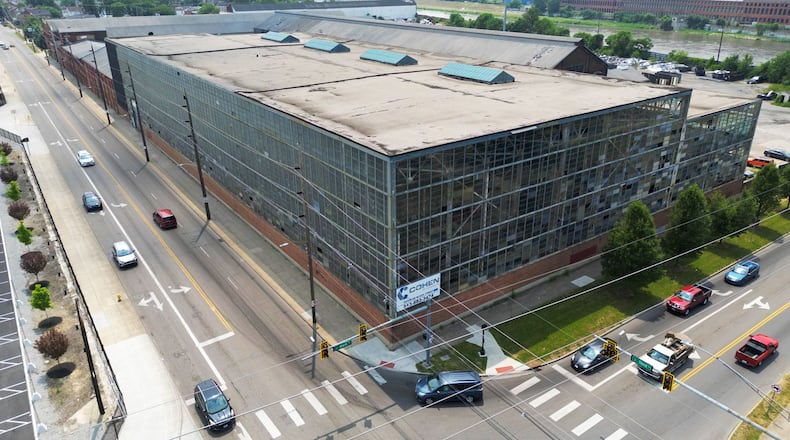The developer is proposing a multi-million mixed-use area that will feature a hotel, apartments, townhomes and retail space.
Credit: Nick Graham
Credit: Nick Graham
The Martin Luther King Jr. Boulevard/North Third Street corridor, from High Street to the Black Street Bridge, as well as the High-Main corridor, is a desirable place for businesses to invest, something Smith said would not have been possible 13 years ago.
Dublin-based Crawford Hoying is planning a three-phase overhaul of the recycling plant for a multi-faceted with a minimum investment of $150 million. Phase 1 calls for a 120-room hotel, 176 apartments, six townhomes, and 5,000 square feet of retail space.
Crawford Hoying has a track record with big projects, including in Ohio alone, owning Dublin’s Bridge Park, Dayton’s Water Street District and Cincinnati’s The Banks projects. The Cohen property, which is 17.7 acres, is along the Great Miami River and across from Spooky Nook Sports Champion Mill.
Hamilton’s efforts over the past 13 years have led to this development, which Smith said is a better vision than the one told to him on his first day on the job. The city then envisioned a conveyer to move coal across North Third Street to the power plant and to make the property that is now the North Third Street parking lot a “trash to energy site.”
“That was the two big visions for that corridor, so I’m happy those two things never materialized because I think the investment we’re going to see at this and other developments are certainly better for the citizens,” Smith said.
In the coming council meetings, Smith said City Council will see come before it a lot of development agreements and site plans up and down the MLK Jr. Boulevard corridor and the High and Main corridor, which he said “is an indication of what’s happening.”
“If you follow any type of financial news, with interest rates that have gone up with some inflationary pressure and some other things, a lot of development in other areas has slowed down,” he said. “I would say our deal flow today is more robust than at any point since I’ve been here, and that’s a testament to our strong team, and people find Hamilton, Ohio, to be a very desirable place to deploy capital.”
City Council, in two weeks, will consider the development agreement, which includes a $3 million loan, which has the potential to be forgivable if certain thresholds are met on their project’s timeline.
Pending the approval of the agreement with the city, Crawford Hoying is expected to close on the Cohen property in August, and site work and demolition would start in 2024, which would allow Cohen Recycling to wind down operations and relocate to its new smaller site north on North Third Street.
Construction would start in 2025, and begins the first phase of three, and each phase is to have a minimum of $50 million of development, according to the draft agreement. Phase 1 is to be finished by December 2026. The second phase and second $50 million increment must be completed by 2031, and the last phase and $50 million increment must be done by 2036.
If they meet the investment minimums and incremental thresholds, then the $3 million loan would be converted into a grant, and the city would repay itself through tax increment financing associated with the project, per the development agreement. If any threshold is missed, then the developer would have to repay a prorated portion of the loan. For example, if Phase 1 is completed late, Crawford Hoying would be required to pay $1 million of the loan.
Smith doubts they’ll miss any threshold, and in fact, the company will likely surpass them. The developer’s signature project is Bridge Park in Dublin. That 20-acre project had a minimum investment of $200 million, and Smith said they had quadrupled that amount with more than $800 million of development.
To compare Phase 1 of the project to current Hamilton businesses and projects, the planned 120-room hotel has the exact same number of rooms as the Courtyard by Marriott in downtown Hamilton; the 176 apartments are equal to the number of apartments combined in the Marcum Apartments and what’s planned for the Rossville Flats project; and the 5,000 square feet of retail space is equivalent to The Casual Pint, The Pour House and Chick’nCone on Riverfront Plaza.
But in subsequent phases, the project will also include a minimum of a six-restaurant food hall, which Smith said it’s akin to “a fancy food court.” The agreement also contemplates greenspace and rooftop amenities, and there is a desire for the developer to activate the Great Miami River in the immediate area, similar to what’s been done and planned for at and around RiversEdge.
“To have a developer with the gravitas of a Crawford Hoying, I think, is just truly a feather in our cap. They are very well known around the state of Ohio,” Smith said. “I’m thrilled they have an interest in Hamilton, Ohio.”
About the Author


